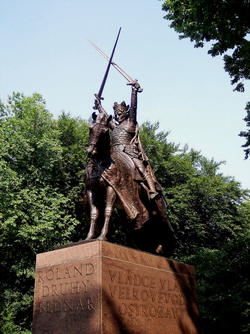User:Moldyvan/Sandbox4: Difference between revisions
(Workshop page for Ostrozava's main history rewrite) |
|||
| (One intermediate revision by the same user not shown) | |||
| Line 3: | Line 3: | ||
{{main|History of Ostrozava}} | {{main|History of Ostrozava}} | ||
===Early history=== | ===Early history=== | ||
{{main|Tervingia}}Settlement of the territory of modern Ostrozava began in the Paleolithic era; sites in northeastern Ostrozava form a continuum with <CIVILIZATION> sites found in [[Ludvosiya]], [[Velikoslavia]], and [[Zamorodna]], which showcase a gradual increase in complexity, including the earliest known evidence of {{Wp|salt mining}} in Belisaria. The | {{main|Tervingia}}Settlement of the territory of modern Ostrozava began in the Paleolithic era; sites in northeastern Ostrozava form a continuum with <CIVILIZATION> sites found in [[Ludvosiya]], [[Velikoslavia]], and [[Zamorodna]], which showcase a gradual increase in complexity, including the earliest known evidence of {{Wp|salt mining}} in Belisaria. The during the {{wp|Bronze Age}} the earliest peoples inhabiting Ostrozava included the {{Wp|Dacians|Valenii}}, {{wp|Thracians|Talencii}}, and several waves of migratory {{wp|Proto-Germanic|Proto-Magnic}} tribes. The latter later {{wp|urbanization|began to urbanize}} around the confluence of the Karmin and Balarog Rivers, leading to the establishment of the Gothic confederation of [[Tervingia]] around 323 BCE. Tervingia developed a strong economy, becoming proficient in agriculture, crop-rotation, and metalworking, eventually controling large swathes of central and eastern Belisaria at its largest extent in 220 CE. Tervingia's borders, largely based on tribute and patronage networks, fluctuated largely, and areas such as Valdavia were often simultaneously subject to demands of tribute and waves of settlement from both the [[Latium|Latin]] and Tervingian Empires, with the former taking direct control of southern Tervingia in 292 CE for a period of 100 years. Successive migrations of {{wp|Slavic peoples|Ludic peoples}} continued to drastically impact the societal makeup of Tervingia, led to the introduction of syncretic forms of [[Nazarism]] which replaced the earlier {{wp|Asatru|Cult of Tyr}}, and slowly eroded the centralized power of the empire, which culminated in the [[Tervingia|Sack of Saragetra]] and subsequent collapse of Tervingia in 428 CE. | ||
After Tervingia's collapse, several new polities emerged, chief among them the [[Ostro-Ludzic|Gotho-Ludzic]] Kingdom of Karsko in the north and the {{wp|Common Romanian|Eastern Latinic}} Kingdom of Valdavia in the south. Spurred by the increasing arrival of displaced missionaries and adherents from [[Latium|western Belisaria]], the earlier Nazarist syncreticism in Transkarminia began to give way to codified {{wp|feudalism|feudal}} systems anchored in [[Alban Nazarism]]. While the collapse had reduced the former Tervingian capital of Saragetra to a mere village by the late 8th century, settlements such as [[Karsko]], Balta, Levigorsk, and Helbarstatt continued to grow, with several migratory waves continuing to impact the ethnic makeup of the region, leading to the displacement of Gothic remnants to the future [[Ludvosiya]], the [[Azdraï]] or their assimilation by the local populace. | |||
===Medieval Period=== | ===Medieval Period=== | ||
[[File:RolandIIStatue.png|250px|thumb|left|An 1889 statue of Roland II in Wittenburg, Rheigen.]] | By the mid-9th century, the Kingdom of Karsko's expansion into northern territories including Vamo, Ardovia, and Baderia had quickened owing to its economic growth from the {{wp|amber trade}} making it a hub for mercenaries, mainly composed of Gothic and Ludic tribesmen. One such confederation of tribesmen, arriving from the north from what is now [[Drevstran]], invaded and took control of Karsko from the ruling Bednar family in 962. Their leader, Roland Válek, a military commander who claimed descent from Queen Lorelei of Tervingia, consolidated power by becoming the first Voivodar of Ostrozava and establishing the Válek dynasty in 967 CE. Subsequently, the Dukes of Ardovia and Vamo swore fealty to the nascent Ostrozava, emboldening political willpower for further territorial growth. In the south, Valdavian dukes attempted an expansion into Rheigen and the Gariman plain in 1001 but was repulsed by forces of the nascent [[Holy Audonian Empire]], which began to pay increasing attention to the Alban polities around Lake Kupalnitsa, which they considered heretical; this culminated in the failed [[Alban crusades|Valdavian Crusade]] in 1197, which nevertheless greatly weakened Valdavia. By 1240, after having failed to entrench a series of political marriages with Valdavian rulers under Otmar I "The Builder", Ostrozava instead invaded Valdavia under his successors Zikmund I and Roland II "The Great", pre-empting a potential second crusade while Fabrian and Holy Audonian attention had been on the [[Lushyodorstag|Lushyods]] to the east, taking not only Valdavia but also the Audonian provinces of Rheigen and Polnitsa in the [[History of Ostrozava|Ostrozavan Wars of Expansion]]. [[File:RolandIIStatue.png|250px|thumb|left|An 1889 statue of Roland II in Wittenburg, Rheigen.]] | ||
By 1300, the Ostrozavan Voivodarate had begun to portray itself as the primary defender of the Alban faith, bringing with them an ethnically and religiously diverse populace; revolt was common, and a series of Fabrian uprisings would halt further expansion southwards by 1310, coupled with the increasing threat of a second wave of crusades. Embittered by the potential of increasing retaliatory aggression from the Fabrians, Roland II began the [[Lushyodorstag#Emendatic_Wars|Emendatic Wars]] when he invaded the Lushyodorstag in 1318, hoping to reclaim the [[Alban Pentapolis]] and further consolidate Alban control over the southern Kupalnitsa. However, the invasion was a failure, and led to the death of the Ostrozavan heir, Gabriel, at the [[Barbellon|Second Battle of Barbellon]]. The subsequent poltical turmoil after Prince Gabriel's death and the loss of the Pentapolis would put a permanent stop to Ostrozavan expansionism and embitter the nobility. Between 1329 and 1335, Kamil Válek, Count of Karschberg and third-in-line to the throne, challenged the new High Voivodar Viktor's claim, leading to the [[History of Ostrozava|First War of Ostrozavan Succession]], which would end in a victory and consolidation of power for Viktor, and the adoption of a defensive posture, resulting in developmental improvments in infrastructural, judicial, and diplomatic norms. While some of the new Ostrozavan accquisitions, such as Rheigen, continued to be marred by religious turmoil, the increasing interconnectedness of Ostrozavan and Valdavian land proved beneificial for development; it became customary for a Voivodar of Ostrozava to marry a Valdavian princess, further entrenching the political capital of the Valek dynasty regionally. Urban life began to develop in earnest after <DEPOPULATION EVENT>, with a class of multi-ethnic urban burghers organized into guilds emerging and providing an economic boon to the region. While many of these burghers were locals, they also began to count among their ranks [[Jewish diaspora (Ajax)|Kupalnitsan Jews]] arriving from the Alban Pentapolis, Lushyods, [[Ludz]] of the Drev, Rheigners, and Schaumbergers. This cosmopolitan influx of trade led to the revitalization of the former Tervingian capital of Saragetra, which was strategically located at an important confluence of Transkarminian trade, and of Levigorsk, whose port served as the closest link between the Ostrozavan lands and those of the [[Alban Pentapolis]]. Tensions with Fabrian minorities, both in Magnic Rheigen and Ludic Ardovia, however, continued to marr stability and generate tensions with the Fabrian world to the south and southwest, especially as more missionaries continued to arrive across the trade routes. | |||
===Eastern Renaissance=== | ===Eastern Renaissance=== | ||
{{main|Eastern Renaissance}} | {{main|Eastern Renaissance}} | ||
After Viktor II's brief reign and death from {{wp|tuberculosis|consumption}} in 1398, his young son Aurel I assumed the throne, under a regency council headed by Duke Zigmund Láska of Litonín. | |||
===Declension and Velikoslavian Suzerainity=== | ===Declension and Velikoslavian Suzerainity=== | ||
[[File:OstrozavaMapThicc-Declension1520B.png|300px|thumb|right|Map of Transkarminia in 1514, showing the results of the declension.]] | [[File:OstrozavaMapThicc-Declension1520B.png|300px|thumb|right|Map of Transkarminia in 1514, showing the results of the declension.]] | ||
===Vykopal Era & [[Thirty Years War]]=== | ===Vykopal Era & [[Thirty Years War]]=== | ||
[[File:AlianaVykopalN.png|thumb|250px|left|Empress Aliana's 55-year reign marked the height of Vykopal power.]] | [[File:AlianaVykopalN.png|thumb|250px|left|Empress Aliana's 55-year reign marked the height of Vykopal power.]] | ||
====Growing Unrest==== | ====Growing Unrest==== | ||
Rioting and strikes of minor industries intensified over the next half-decade; in 1905 the Empire of Transkarminia formally abolished serfdom, being one of the last states in Belisaria to commit to the policy. The abolition of serfdom sent hundreds of former serfs flooding into the cities, creating a homelessness crisis amid the winter of 1905-06, which saw over 2,500 dead of hypothermia. The Black Winter of 1906, named for the frostbitten former serfs' blackened features, would see blame laid at the feet of the Vykopal dynasty.''Utrătenia''[[File:Alexander Wienerberger Holodomor18.jpg|thumb|left]] | Rioting and strikes of minor industries intensified over the next half-decade; in 1905 the Empire of Transkarminia formally abolished serfdom, being one of the last states in Belisaria to commit to the policy. The abolition of serfdom sent hundreds of former serfs flooding into the cities, creating a homelessness crisis amid the winter of 1905-06, which saw over 2,500 dead of hypothermia. The Black Winter of 1906, named for the frostbitten former serfs' blackened features, would see blame laid at the feet of the Vykopal dynasty.''Utrătenia''[[File:Alexander Wienerberger Holodomor18.jpg|thumb|left]] | ||
Revision as of 13:42, 6 July 2024
History
Early history
Settlement of the territory of modern Ostrozava began in the Paleolithic era; sites in northeastern Ostrozava form a continuum with <CIVILIZATION> sites found in Ludvosiya, Velikoslavia, and Zamorodna, which showcase a gradual increase in complexity, including the earliest known evidence of salt mining in Belisaria. The during the Bronze Age the earliest peoples inhabiting Ostrozava included the Valenii, Talencii, and several waves of migratory Proto-Magnic tribes. The latter later began to urbanize around the confluence of the Karmin and Balarog Rivers, leading to the establishment of the Gothic confederation of Tervingia around 323 BCE. Tervingia developed a strong economy, becoming proficient in agriculture, crop-rotation, and metalworking, eventually controling large swathes of central and eastern Belisaria at its largest extent in 220 CE. Tervingia's borders, largely based on tribute and patronage networks, fluctuated largely, and areas such as Valdavia were often simultaneously subject to demands of tribute and waves of settlement from both the Latin and Tervingian Empires, with the former taking direct control of southern Tervingia in 292 CE for a period of 100 years. Successive migrations of Ludic peoples continued to drastically impact the societal makeup of Tervingia, led to the introduction of syncretic forms of Nazarism which replaced the earlier Cult of Tyr, and slowly eroded the centralized power of the empire, which culminated in the Sack of Saragetra and subsequent collapse of Tervingia in 428 CE.
After Tervingia's collapse, several new polities emerged, chief among them the Gotho-Ludzic Kingdom of Karsko in the north and the Eastern Latinic Kingdom of Valdavia in the south. Spurred by the increasing arrival of displaced missionaries and adherents from western Belisaria, the earlier Nazarist syncreticism in Transkarminia began to give way to codified feudal systems anchored in Alban Nazarism. While the collapse had reduced the former Tervingian capital of Saragetra to a mere village by the late 8th century, settlements such as Karsko, Balta, Levigorsk, and Helbarstatt continued to grow, with several migratory waves continuing to impact the ethnic makeup of the region, leading to the displacement of Gothic remnants to the future Ludvosiya, the Azdraï or their assimilation by the local populace.
Medieval Period
By the mid-9th century, the Kingdom of Karsko's expansion into northern territories including Vamo, Ardovia, and Baderia had quickened owing to its economic growth from the amber trade making it a hub for mercenaries, mainly composed of Gothic and Ludic tribesmen. One such confederation of tribesmen, arriving from the north from what is now Drevstran, invaded and took control of Karsko from the ruling Bednar family in 962. Their leader, Roland Válek, a military commander who claimed descent from Queen Lorelei of Tervingia, consolidated power by becoming the first Voivodar of Ostrozava and establishing the Válek dynasty in 967 CE. Subsequently, the Dukes of Ardovia and Vamo swore fealty to the nascent Ostrozava, emboldening political willpower for further territorial growth. In the south, Valdavian dukes attempted an expansion into Rheigen and the Gariman plain in 1001 but was repulsed by forces of the nascent Holy Audonian Empire, which began to pay increasing attention to the Alban polities around Lake Kupalnitsa, which they considered heretical; this culminated in the failed Valdavian Crusade in 1197, which nevertheless greatly weakened Valdavia. By 1240, after having failed to entrench a series of political marriages with Valdavian rulers under Otmar I "The Builder", Ostrozava instead invaded Valdavia under his successors Zikmund I and Roland II "The Great", pre-empting a potential second crusade while Fabrian and Holy Audonian attention had been on the Lushyods to the east, taking not only Valdavia but also the Audonian provinces of Rheigen and Polnitsa in the Ostrozavan Wars of Expansion.
By 1300, the Ostrozavan Voivodarate had begun to portray itself as the primary defender of the Alban faith, bringing with them an ethnically and religiously diverse populace; revolt was common, and a series of Fabrian uprisings would halt further expansion southwards by 1310, coupled with the increasing threat of a second wave of crusades. Embittered by the potential of increasing retaliatory aggression from the Fabrians, Roland II began the Emendatic Wars when he invaded the Lushyodorstag in 1318, hoping to reclaim the Alban Pentapolis and further consolidate Alban control over the southern Kupalnitsa. However, the invasion was a failure, and led to the death of the Ostrozavan heir, Gabriel, at the Second Battle of Barbellon. The subsequent poltical turmoil after Prince Gabriel's death and the loss of the Pentapolis would put a permanent stop to Ostrozavan expansionism and embitter the nobility. Between 1329 and 1335, Kamil Válek, Count of Karschberg and third-in-line to the throne, challenged the new High Voivodar Viktor's claim, leading to the First War of Ostrozavan Succession, which would end in a victory and consolidation of power for Viktor, and the adoption of a defensive posture, resulting in developmental improvments in infrastructural, judicial, and diplomatic norms. While some of the new Ostrozavan accquisitions, such as Rheigen, continued to be marred by religious turmoil, the increasing interconnectedness of Ostrozavan and Valdavian land proved beneificial for development; it became customary for a Voivodar of Ostrozava to marry a Valdavian princess, further entrenching the political capital of the Valek dynasty regionally. Urban life began to develop in earnest after <DEPOPULATION EVENT>, with a class of multi-ethnic urban burghers organized into guilds emerging and providing an economic boon to the region. While many of these burghers were locals, they also began to count among their ranks Kupalnitsan Jews arriving from the Alban Pentapolis, Lushyods, Ludz of the Drev, Rheigners, and Schaumbergers. This cosmopolitan influx of trade led to the revitalization of the former Tervingian capital of Saragetra, which was strategically located at an important confluence of Transkarminian trade, and of Levigorsk, whose port served as the closest link between the Ostrozavan lands and those of the Alban Pentapolis. Tensions with Fabrian minorities, both in Magnic Rheigen and Ludic Ardovia, however, continued to marr stability and generate tensions with the Fabrian world to the south and southwest, especially as more missionaries continued to arrive across the trade routes.
Eastern Renaissance
After Viktor II's brief reign and death from consumption in 1398, his young son Aurel I assumed the throne, under a regency council headed by Duke Zigmund Láska of Litonín.
Declension and Velikoslavian Suzerainity
Vykopal Era & Thirty Years War
Growing Unrest
Rioting and strikes of minor industries intensified over the next half-decade; in 1905 the Empire of Transkarminia formally abolished serfdom, being one of the last states in Belisaria to commit to the policy. The abolition of serfdom sent hundreds of former serfs flooding into the cities, creating a homelessness crisis amid the winter of 1905-06, which saw over 2,500 dead of hypothermia. The Black Winter of 1906, named for the frostbitten former serfs' blackened features, would see blame laid at the feet of the Vykopal dynasty.Utrătenia
Crimson Revolution & First Compact
Rytieriroz and Growing Regional Tensions
Containment War & Socialist Consolidation
Second Compact and Great Republican War

The Correction
Third Compact






